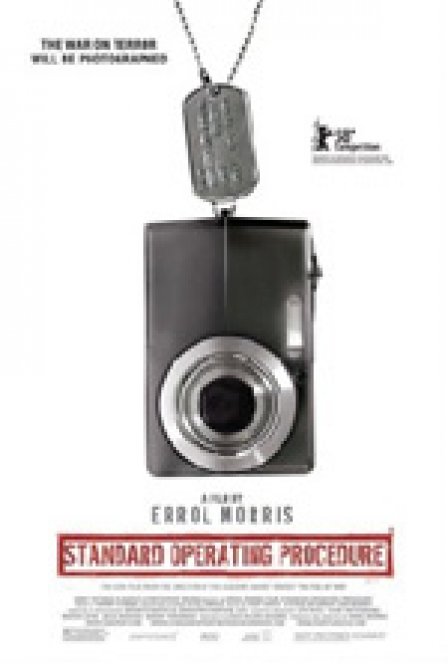In his last film, The Fog of War, director Errol Morris, like a good prosecuting attorney, masterfully allowed Robert S. McNamara, the U.S. Secretary of Defense during the Vietnam War, the freedom and space to incriminate himself. Strictly by letting McNamara ramble, Morris got him to expose his own shallow sense of morality and lack of personal compassion. But The Fog of War was only as provocatively intelligent as it was chilling because of Morris’ ability to delve into the complexity and moral ambiguity inherent in political leadership. McNamara’s views were often repulsive, but in many moments of the film the viewer saw that, at times, the former Secretary had no good options to choose from – anything he decided would result in deaths on one side of the Vietnam conflict. The Fog of War failed to make McNamara a sympathetic character, but it at least humanized him a bit.
Unfortunately, Standard Operating Procedure, Morris’ new film about the U.S. soldiers who participated in the torture of Iraqi prisoners at Abu Ghraib, lacks such intellectual complexity. Morris rightly seeks to set the blame for the Abu Ghraib catastrophe at the feet of the Bush Administration officials who adopted ritual torture, humiliation, and debasement as the military’s standard procedural doctrine. But this focus causes Morris to overlook the individual responsibility of each soldier who went along with the policy. It was individuals, not a policy, that forced Iraqi prisoners to stay in stress positions for hours on end, to masturbate in front of one another, to be led on leashes like dogs, and to strip and then form a human pyramid. And it was the individual U.S. soldiers who photographed these events and treated the pictures like prized trophies.
Morris fails to challenge his interviewees. During the questioning, he allows Lynndie England and Sabrina Harman, two of the most notorious participants, to portray themselves as victims. The film concludes by focusing on the extenuating circumstances that caused the soldiers to act so repulsively: the lack of oversight; the constant attacks staged on Abu Ghraib by insurgents; the horrendous living conditions the soldiers experienced at the prison; the youth and inexperience of those involved. But while Donald Rumsfeld and Dick Cheney certainly bear greater responsibility for the torture at Abu Ghraib than the participating soldiers, England and Harman are no innocents. We would not exculpate lowly Nazi soldiers for murdering Jews or Poles because they were following Hitler’s policies. Shouldn't we hold our own our own MPs to the same standards?
The soldiers themselves appear strikingly vapid in their reflections and justifications, and this factor alone may help to explain their behavior. England repeatedly states that she does not feel any remorse and would not go back and change anything, even if she could. She becomes angry only when speaking about Charles Graner, another soldier at Abu Ghraib, with whom she had a romantic relationship at the prison. She blames her misconduct on youthful indiscretion and the blindness that love brings. The soldiers in general concentrate more on the unfairness of their own punishments (seven served time for their involvement in taking the photos) than on the cruelty they enacted on their prisoners.
But Standard Operating Procedure’s most profound flaws are cinematic. Morris fills the movie with slow-motion dramatic reenactments of the scenes his interviewees describe, including a boy prisoner being covered by ants and a dream of Harman’s involving an exploding helicopter. Utterly misguided, the reenactments serve no purpose and suggest that Morris is primarily interested in showing off his compositional skills. Danny Elfman only exacerbates the situation by providing a hideous soundtrack, punctuated by eerie keyboards and vibrating resonances straight out of a B horror film, to almost schlocky effect. Abu Ghraib is a subject that needs no additional dramatic weight. Morris could have (and should have) relied exclusively on the impact of his material to convey tragedy to the viewer. Instead, he decided to overplay his own directorial hand, never permitting the viewer to forget that he or she is watching a film.
In interviews, Morris has frequently stated that one of the main ideas behind the film was that photos only show a subjective reality. He shows that many of the Abu Ghraib photos that caused a public scandal were cropped to leave out certain officials. Other photos were deliberately staged. But so what? The photographs are not forgeries; U.S. soldiers did torture prisoners. Morris alleges that what happened off camera was far worse than what appeared in the pictures, but this doesn’t mean Harman, England, and Graner should be absolved for their participation; it's ridiculousness enough that only “seven bad apples” have been punished for Abu Ghraib. In a press release, Morris said he sought to convey the complexity of Abu Ghraib and that viewers often mistake complexity for exoneration. In fact, Morris seems unable to deal with the complexity of Abu Ghraib and ultimately seems to tolerate the intolerable. Morris’ ideas lead us down a slippery slope – if morality is purely situational, then what's the point of having morals at all? Instead of improving our understanding of Abu Ghraib, Standard Operating Procedure only leaves us more perplexed.

